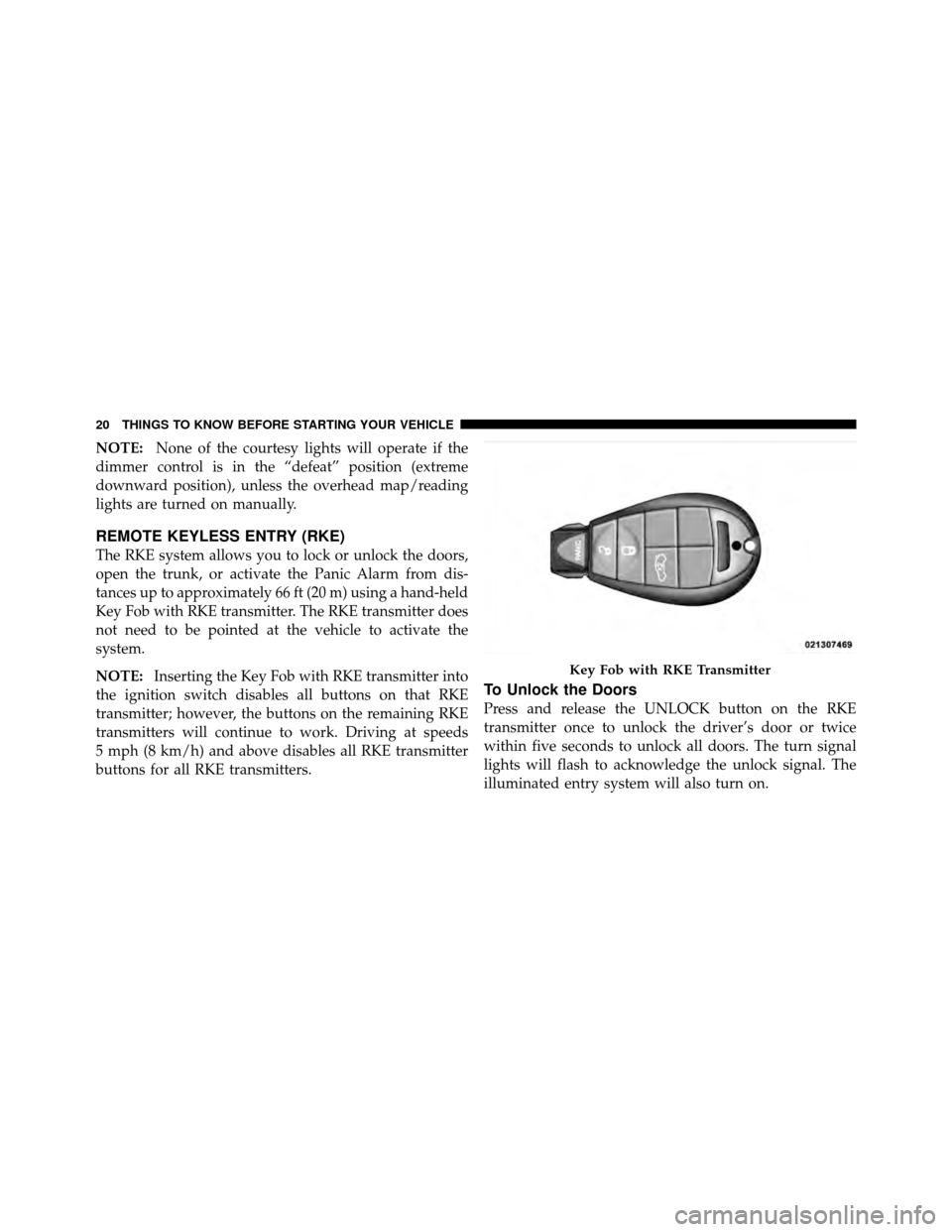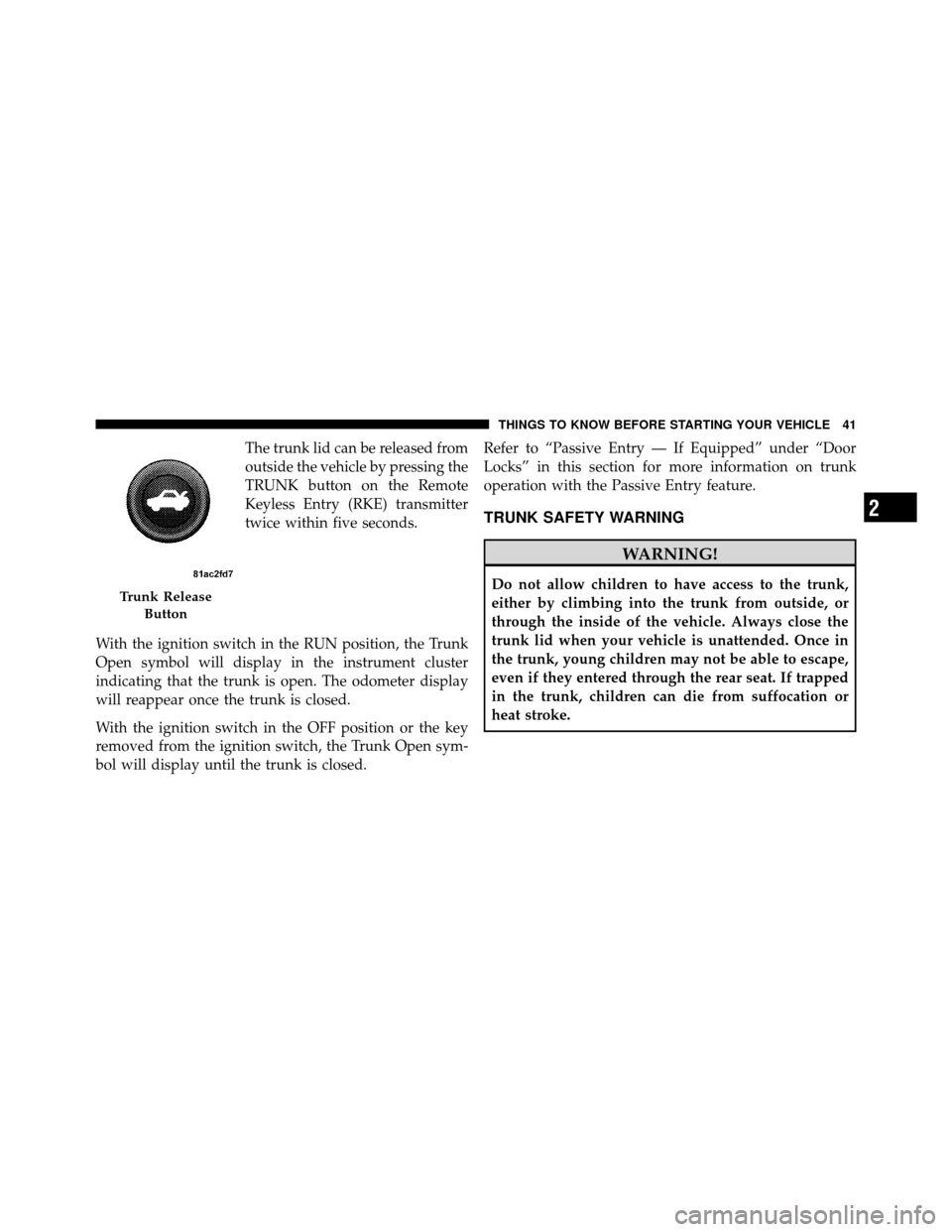Page 11 of 465

▫Using The Panic Alarm ................. 22
▫ Programming Additional Transmitters ...... 23
▫ Transmitter Battery Replacement .......... 23
▫ General Information ................... 24
� Remote Starting System — If Equipped ....... 24
▫ How To Use Remote Start ............... 25
� Door Locks ........................... 27
▫ Manual Door Locks ................... 27
▫ Power Door Locks .................... 28
▫ Passive Entry System — If Equipped ....... 32
▫ Child Protection Door Lock .............. 34
� Windows ............................ 37
▫ Power Windows ...................... 37 ▫
Wind Buffeting ....................... 40
� Trunk Lock And Release ................. 40
� Trunk Safety Warning ................... 41
▫ Trunk Emergency Release ............... 42
� Occupant Restraints ..................... 42
▫ Lap/Shoulder Belts .................... 44
▫ Lap/Shoulder Belt Untwisting Procedure .... 49
▫ Automatic Locking Retractors (ALR) Mode
— If Equipped ....................... 50
▫ Seat Belt Pretensioners — If Equipped ...... 50
▫ Enhanced Seat Belt Use Reminder System
(BeltAlert�) ......................... 51
▫ Seat Belts And Pregnant Women .......... 53
▫ Seat Belt Extender ..................... 53
10 THINGS TO KNOW BEFORE STARTING YOUR VEHICLE
Page 21 of 465

NOTE:None of the courtesy lights will operate if the
dimmer control is in the “defeat” position (extreme
downward position), unless the overhead map/reading
lights are turned on manually.
REMOTE KEYLESS ENTRY (RKE)
The RKE system allows you to lock or unlock the doors,
open the trunk, or activate the Panic Alarm from dis-
tances up to approximately 66 ft (20 m) using a hand-held
Key Fob with RKE transmitter. The RKE transmitter does
not need to be pointed at the vehicle to activate the
system.
NOTE: Inserting the Key Fob with RKE transmitter into
the ignition switch disables all buttons on that RKE
transmitter; however, the buttons on the remaining RKE
transmitters will continue to work. Driving at speeds
5 mph (8 km/h) and above disables all RKE transmitter
buttons for all RKE transmitters.
To Unlock the Doors
Press and release the UNLOCK button on the RKE
transmitter once to unlock the driver’s door or twice
within five seconds to unlock all doors. The turn signal
lights will flash to acknowledge the unlock signal. The
illuminated entry system will also turn on.
Key Fob with RKE Transmitter
20 THINGS TO KNOW BEFORE STARTING YOUR VEHICLE
Page 23 of 465

If the vehicle is equipped with Passive Entry, refer to
“Passive Entry System — If Equipped” under “Door
Locks” for further information.
Sound Horn with Remote Key Lock
This feature will cause the horn to chirp when the doors
are locked with the RKE transmitter, or locked using the
Passive Entry door handle lock button. This feature can
be turned on or turned off. Refer to “Electronic Vehicle
Information Center (EVIC)/Personal Settings (Customer-
Programmable Features)” in “Understanding Your In-
strument Panel” for further information.
To Unlatch the Trunk
Press the TRUNK button on the RKE transmitter two
times within five seconds to unlatch the trunk.
Refer to “Passive Entry System — If Equipped” under
“Door Locks” for further information
Using the Panic Alarm
To turn the Panic Alarm feature on or off, press and hold
the PANIC button on the RKE transmitter for at least one
second and release. When the Panic Alarm is on, the
headlights and park lights will flash, the horn will pulse
on and off, and the interior lights will turn on.
The Panic Alarm will stay on for three minutes unless
you turn it off by either pressing the PANIC button a
second time or drive the vehicle at a speed of 15 mph
(24 km/h) or greater.
NOTE:
•The interior lights will turn off if you turn the ignition
switch to the ACC or ON position while the Panic
Alarm is activated. However, the exterior lights and
horn will remain on.
22 THINGS TO KNOW BEFORE STARTING YOUR VEHICLE
Page 41 of 465

Reset
Anytime the vehicle battery is disconnected or goes dead,
the AUTO-up function will be disabled. To reactivate the
AUTO-up feature, perform the following procedure after
vehicle power is restored:
1. Pull the window switch up to close window com-
pletely and continue to hold the switch up for an
additional two seconds after the window is closed.
2. Push the window switch down firmly to the second
detent to open the window completely and continue to
hold the switch down for an additional two seconds after
the window is fully open.
Wind Buffeting
Wind buffeting can be described as the perception of
pressure on the ears or a helicopter-type sound in the
ears. Your vehicle may exhibit wind buffeting with the
windows down, or the sunroof (if equipped) in certainopen or partially open positions. This is a normal occur-
rence and can be minimized. If the buffeting occurs with
the rear windows open, then open the front and rear
windows together to minimize the buffeting. If the
buffeting occurs with the sunroof open, then adjust the
sunroof opening to minimize the buffeting.
TRUNK LOCK AND RELEASE
The trunk lid can be released from inside the vehicle by
pressing the TRUNK RELEASE button located on the
instrument panel to the left of the steering wheel.
NOTE:
The transmission must be in PARK before the
button will operate.
40 THINGS TO KNOW BEFORE STARTING YOUR VEHICLE
Page 42 of 465

The trunk lid can be released from
outside the vehicle by pressing the
TRUNK button on the Remote
Keyless Entry (RKE) transmitter
twice within five seconds.
With the ignition switch in the RUN position, the Trunk
Open symbol will display in the instrument cluster
indicating that the trunk is open. The odometer display
will reappear once the trunk is closed.
With the ignition switch in the OFF position or the key
removed from the ignition switch, the Trunk Open sym-
bol will display until the trunk is closed. Refer to “Passive Entry — If Equipped” under “Door
Locks” in this section for more information on trunk
operation with the Passive Entry feature.
TRUNK SAFETY WARNING
WARNING!
Do not allow children to have access to the trunk,
either by climbing into the trunk from outside, or
through the inside of the vehicle. Always close the
trunk lid when your vehicle is unattended. Once in
the trunk, young children may not be able to escape,
even if they entered through the rear seat. If trapped
in the trunk, children can die from suffocation or
heat stroke.Trunk Release
Button
2
THINGS TO KNOW BEFORE STARTING YOUR VEHICLE 41
Page 43 of 465
Trunk Emergency Release
The trunk of your vehicle is equipped with an emergency
release handle. It is located on the inside of the trunk lid,
near the latch, and is coated so that it glows in a darkened
trunk. Pull on the handle to open the trunk.
OCCUPANT RESTRAINTS
Some of the most important safety features in your
vehicle are the restraint systems:
•Three-point lap and shoulder belts for the driver and
all passengers
•Advanced Front Airbags for driver and front passen-
ger
•Supplemental Side Airbag Inflatable Curtains (SABIC)
for the driver and passengers seated next to a window
— if equipped
•An energy-absorbing steering column and steering
wheel
•Knee bolsters/blockers for front seat occupants
•Front seat belts incorporate pretensioners to enhance
occupant protection by managing occupant energy
during an impact event — if equipped
Trunk Emergency Release
42 THINGS TO KNOW BEFORE STARTING YOUR VEHICLE
Page 188 of 465
INSTRUMENT PANEL FEATURES
1 — Air Outlet7 — Radio13 — Ignition Switch
2 — Instrument Cluster 8 — Climate Control14 — Hood Release
3 — Hazard Switch 9 — Heated Seat Switch*15 — Trunk Release Button
4 — Analog Clock 10 — Power Outlet16 — Headlight Switch
5 — Electronic Stability Program Off Button* 11 — Ash Tray* * If Equipped
6 — Glove Compartment 12 — Storage Compartment*
4
UNDERSTANDING YOUR INSTRUMENT PANEL 187
Page 449 of 465

Disabled Vehicle Towing................... 360
Disposal Antifreeze (Engine Coolant) ............... 386
Engine Oil ........................... 372
Door Locks ............................. 27
Door Locks, Automatic .................... 29
Door Opener, Garage ..................... 164
Driving On Slippery Surfaces ................... 290
Through Flowing, Rising, or Shallow
Standing Water ........................ 291
DVD Player (Video Entertainment System™) .... 258
Electric Rear Window Defrost ............... 181
Electric Remote Mirrors .................... 92
Electrical Power Outlets ................... 174
Electronic Brake Control System ............. 300
Electronic Speed Control (Cruise Control) ...... 155
Electronic Stability Program (ESP) ............ 302Electronic Throttle Control Warning Light
...... 195
Electronic Vehicle Information Center (EVIC) .... 199
Emergency Deck Lid Release ................ 42
Emergency, In Case of Freeing Vehicle When Stuck ............... 359
Hazard Warning Flasher ................. 344
Jump Starting ......................... 355
Overheating .......................... 344
Towing ............................. 360
Emergency Trunk Release ................... 42
Emission Control System Maintenance ......367,416
Engine ............................... 365
Air Cleaner .......................... 372
Block Heater ......................... 280
Break-In Recommendations ................ 78
Checking Oil Level ..................... 370
Compartment ......................... 365
Coolant (Antifreeze) ................. 382,413
Cooling ............................. 382
448 INDEX